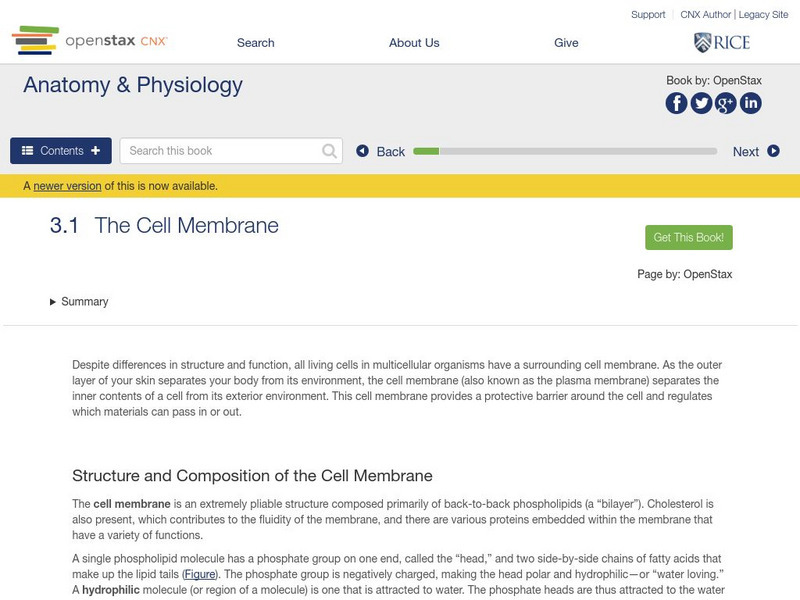Hi, what do you want to do?
Curated OER
Leffingwell and Associates: Olfaction
Provides a technical discussion of the anatomy and physiology involved in the receptors associated with the sense of smell. Includes pictures and formulas.
Curated OER
Leffingwell and Associates: Olfaction
Provides a technical discussion of the anatomy and physiology involved in the receptors associated with the sense of smell. Includes pictures and formulas.
Other
Look d.com: Fish Circulation
This site from LookD.com provides information about bony fish circulation systems. The article is very brief, only one paragraph in length, but worth checking out on the subject.
Other
Cartage.org: Abnormal Circulation
Causes of heart failure, signs and characteristics of heart failure, pathologic conditions resulting in heart failure, and more are the topics addressed in this thorough resource.
Other
Dr. Saul: Biology in Motion
This interactive site provides animations and activities in several areas of physiology. The images are simple, but clear. The accompanying text provides a good description of the process being shown.
University of Utah
University of Utah: Cardiovascular Pathology Index
This site features a detailed index of photographs for cardiovascular pathology. You can see what a normal human heart looks like and what a sick one looks like too. Come and check it out.
North Central Regional Educational Laboratory
Ncrel: Human Body Systems Resource
What do you know about the different human body systems? This site features information on each of the different systems. Students and teachers will benefit from this comprehensive resource.
National Cancer Institute at the National Institutes of Health
Seer Training Modules: Introduction to the Human Body
Self-guided learning activity where students learn about the functions, processes, and anatomy of the human body. There is a short quiz at the end of the lesson to check for understanding.
EL Education
El Education: Autumn Helena Washington Hawn
This Character File (CF) was created by a 5th/6th grade student in Shutesbury, Massachusetts, as part of a learning expedition on Deaf Culture. Students did fieldwork at four schools for the Deaf, including overnight exchange visits; all...
Other
Inside the Human Body: The Respiratory System (Professair's Mad Lab)
Have fun learning about the human body's respiratory system while playing games in Professair's Mad Lab! These interactive games have colorful graphics and are broken into three grade groupings: grades one to three, four to six, and...
Other
Inside the Human Body: The Respiratory System (Grades 7 12 Teacher Resources)
This teacher's resource page accompanies the student website ?Inside the Human Body: The Respiratory System? for grades seven through twelve from the Canadian Lung Association. This site walks teachers through the features of the student...
Other
Inside the Human Body: The Respiratory System (Grades 4 6 Teacher Resources)
This teacher's resource page accompanies the student website "Inside the Human Body: The Respiratory System" for grades four through six from the Canadian Lung Association. This site walks teachers through the features of the student...
OpenStax
Open Stax: Functions of Human Life
The different organ systems each have different functions and therefore unique roles to perform in physiology. These many functions can be summarized in terms of a few that we might consider definitive of human life. Learn here about the...
OpenStax
Open Stax: Layers of the Skin
Learn here about skin. Skin is made of multiple layers of cells and tissues, which are held to underlying structures by connective tissue.
OpenStax
Open Stax: Embryonic Development of the Axial Skeleton
The axial skeleton begins to form during early embryonic development. However, growth, remodeling, and ossification continue for several decades after birth before the adult skeleton is fully formed. Knowledge of the developmental...
OpenStax
Open Stax: Fibrous Joints
Fibrous joints are explained here. At a fibrous joint, the adjacent bones are directly connected to each other by fibrous connective tissue, and thus the bones do not have a joint cavity between them.
OpenStax
Open Stax: The Cell Membrane
Learn here about the structure and function of the cell membrane.
OpenStax
Open Stax: Bone Structure
In this site we examine bone structure. Examine bone cells, markings, tissues and various types of bones.
OpenStax
Open Stax: Bones of the Lower Limb
Learn here all about the bones that make up the lower limb: the thigh, leg and foot.
OpenStax
Open Stax: Classification of Joints
This site provides information regarding the classification of joints. A joint, also called an articulation, is any place where adjacent bones or bone and cartilage come together to form a connection.
OpenStax
Open Stax: Protein Synthesis
Most structural components of the cell are made up, at least in part, by proteins and virtually all the functions that a cell carries out are completed with the help of proteins. This site explains protein synthesis, including that of...
OpenStax
Open Stax: Inorganic Compounds
Learn here about inorganic compounds, substances that do not contain both carbon and hydrogen, and how they are essential to human functioning.
OpenStax
Open Stax: Bones of the Upper Limb
Learn here about the bones of the upper limb. The upper limb is divided into three regions. These consist of the arm, located between the shoulder and elbow joints; the forearm, which is between the elbow and wrist joints; and the hand,...
OpenStax
Open Stax: Organic Compounds Essential to Human Functioning
Learn here about organic compounds, groups of carbon atoms covalently bonded to hydrogen, usually oxygen, and often other elements as well, and how they are essential to human functioning.
Other popular searches
- Heart Anatomy and Physiology
- Anatomy and Physiology Web
- Plant Anatomy and Physiology
- Basic Anatomy and Physiology





















